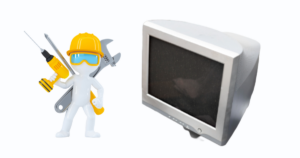Your computer not showing signs of power is anything but a terminal fault. Chances are the lack of power is due to a less severe issue. In most cases, there are simple explanations and relatively easy fixes for this problem. In this blog post, we will explore why a computer may show no sign of power and guide you through troubleshooting steps to help you get your computer back up and running.
Why is My Computer Showing No Signs of Power?
A few common problems can stop your computer from turning on. One possible culprit is a power problem, which could be caused by a faulty internal power supply or a lack of power reaching your computer. Another possibility is that there are loose parts inside your computer or you’re connected to external hardware that’s not working correctly. Consent, it shuts down early when you try to start it up.
10 Ways to Fix a Computer That Shows No Sign of Power

Now that you’re familiar with the possible causes of a computer’s apparent lack of power, let’s explore the steps you can take to troubleshoot and fix this issue for your computer.
1. Verify that You’re Powering on Correctly
One of the most overlooked reasons a computer fails to turn on is simply because you didn’t switch it on in the first place. Before diving into potentially time-consuming troubleshooting steps, it’s crucial to ensure that all power switches and buttons relevant to your computer system are in the correct position:
- Power button/switch. This is typically located on the front of a desktop computer’s case or the top or side of a laptop or tablet.
- Power switch at the back. In the case of a desktop computer, there is often an additional power switch positioned at the back.
- Power switch on peripheral devices. If you are utilizing a power strip, surge protector, or uninterruptible power supply (UPS), remember to check the power switch on these devices.
By confirming that each power switch and button is correctly activated, you can save yourself the trouble of extensive troubleshooting.
2. Check Secure Connections of Computer Power Cables
A computer might not turn on when the power cable is loose or not connected properly. Even if your computer has a battery, checking if the AC adapter is securely plugged in is essential, especially when troubleshooting. If you usually keep your computer plugged in, the cable can become loose without you knowing. Consequently, you’d end up with an empty battery, which could be why your computer is not receiving power.
3. Plug your Computer Directly into a Power Source
We recommend connecting your tablet, laptop, or desktop directly to the wall outlet to troubleshoot further. Doing this will bypass any power strips, battery backups, or other intermediary power devices. By eliminating these additional power distribution devices, you can determine if one of the removed components was causing the issue. If your computer successfully receives power in this configuration, chances are one of the intermediary power distribution devices you’ve bypassed is the culprit. However, if the problem persists even with the direct connection, we recommend continuing troubleshooting with your computer plugged directly into the wall outlet. Simplifying the setup will help isolate the issue and allow for a more straightforward diagnostic process.
4. Check the PSU Voltage Rating
For desktop computers, verifying that the power supply voltage switch is appropriately configured is crucial. This switch determines the input voltage for the power supply unit (PSU) and must be set correctly according to the power standards of your country. Failure to align the voltage setting with the required specifications may result in your computer failing to power on altogether.
5. Remove your Laptop/Tablet’s Main Battery
Consider removing the main battery from your laptop or tablet and relying solely on AC power. It is entirely safe to operate your portable computer without the battery installed. If your computer successfully turns on when using AC power only, it indicates that the battery is likely the underlying cause of the problem. In such a case, we recommend replacing the battery. However, until you can obtain a replacement, you can continue using your computer as long as you have easy access to a power outlet.
6. Replace the Computer Power Cable or AC Adapter
Consider replacing the power cable or AC adapter of your computer. In a desktop case, this refers to the cable connecting the computer case to the power source. For tablets and laptops, the AC adapter is the cable that plugs into the wall to charge the battery, often featuring a small indicator light. A malfunctioning AC adapter is a common culprit when tablets and laptops fail to turn on. Even if you seldom utilize the power cable, its failure would result in inadequate battery charging.
While a faulty power cable is not a frequent cause of power-related issues for desktop PC users, it can occur and is easily verifiable through testing. You can use the power cable from your monitor (if it appears to be receiving power), borrow one from another computer, or obtain a new cable for testing purposes.
7. Replace the CMOS Battery
The CMOS battery maintains essential system settings, such as BIOS settings and the date and time, even when the computer is powered off. Over time, this battery can deteriorate or lose its charge, especially when the main battery is not in place, leading to issues with the power supply. Replacing your computer’s CMOS battery step becomes even more relevant for older systems or those that have spent extended periods powered off or without the main battery.
8. Check the Power Switch — Motherboard Connection
Ensure the power switch is connected correctly to the motherboard, especially with a desktop computer. Although it is not a prevalent point of failure, a disconnected power button can be the reason behind your PC’s inability to turn on. Typically, most case switches are connected to the motherboard using a pair of twisted wires in red and black. The same holds for laptops, but the module is typically inaccessible.
9. Test the PSU
At this stage of troubleshooting, particularly for desktop users, it is highly likely that your computer’s power supply unit (PSU) has ceased functioning and needs replacing. To be on the safer side and avoid replacing a functional component, be sure to verify the PSU condition. Nevertheless, there are instances where specific symptoms indicate a faulty power supply unit without the need for testing.
If you detect an ozone smell or hear a high-pitched noise accompanied by a complete lack of power in your computer, it is almost certain that the power supply has malfunctioned. In such cases, proceed directly to replace the power supply. After installing the new power supply, we recommend plugging the computer in for approximately 5 minutes before powering it on. This allows sufficient time for the CMOS battery to recharge.
10. Test the Power Button
For desktop computer users, you’ll want to test the power button on the front of your computer’s case as a final step in troubleshooting. If the power button fails the testing process, it should be replaced. Motherboards sometimes come equipped with small power buttons integrated directly into the boards. These buttons provide a more straightforward way to test the functionality of the case’s power button. If your motherboard has this feature and successfully powers on your computer when used, it indicates that the case power button likely requires replacement.
Take Away: How to Fix a Computer That Shows No Sign of Power
You have reached the end of this troubleshooting guide, and your computer is running smoothly. However, if you still face issues despite following the troubleshooting steps, it may be time to seek assistance from a professional repair shop.

